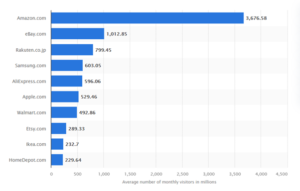There are tons of benefits for brands pivoting to the digital landscape, especially when Covid strikes, forcing everyone to stay at home and practice social distancing.
However, the “digital landscape” is too general – you can sell on marketplaces such as Amazon, eBay, etc., on social media channels such as Facebook, Instagram or build your own website are all eCommerce options. Then among all of these, which is the best? Choosing the best place for your business to sell products online can be a daunting task.
With that being said, we will unveil all the pros and cons of these two options and show you the way how to choose the best selling platform for your products, resources, and most importantly, your vision!
Benefits of selling on a marketplace
Readymade traffic and great exposure with SEO-friendliness
Choosing a popular marketplace is the easy choice as they have established their own name, having their own fans with highly trusted websites.
For instance, Amazon.com had a monthly traffic average of almost 3.68 billion visitors in 2020, followed by eBay.com with 1.01 billion visits on average each month according to Statista.

Most visited online retail websites worldwide in 2020, by average monthly traffic (in million)
Along with the high volume of customers, merchants selling on marketplaces can enjoy the advantages of active customers who are comfortable making purchases on marketplaces and have the habit to go there instead of somewhere new to find products, or just for a quick retail therapy.
Easy to get started and maintain without having to run inventory
It’s very easy to put your product in front of your potential and demand-driven customers on marketplaces because you can start selling there quite easily. For the most part, the most time-consuming task to be executed is showcasing your goods or services for sale, which commonly takes up to one week.
Marketplaces take care of all other technical tasks such as updates, security, and bugs, so merchants do not need to pay for web development services. You also profit from secure payment methods that are equally provided by a marketplace owner.
Moreover, you don’t have to worry about shipping and inventory issues as they have established a complex and enormous supply chain network that is capable of delivering to all buyers.
Downsides of selling on marketplaces
Despite all the attractive advantages, some disadvantages even surged a quitting wave, such as the famous leaving of IKEA in 2019.
Selling fees
All the easy peasy, worry-free features, and advantages of marketplace sellers come at a cost (literally).
On popular service marketplaces like Uber, Fiverr, Lyft and Postmates, the commission hovers around 20%. For product marketplaces, the story is quite different. Etsy charges its merchants 3.5% while the two main players eBay and Amazon hover around 10%. Rental marketplaces seem to have more variance, with Airbnb charging 11% on average and Turo (previously RelayRides) as much as 25%.
Cut-throat competition with multiple competing brands on the same site

The public exposure is still there, but among such a cut-throat competition between brands on the same marketplace and in such a crowd, your store may not necessarily stand out.
Because of many attractive advantages, many merchants are flooding to the most popular marketplaces to fight for customers’ attention there. Even worse, competitors can target shoppers who visit your shops and place advertisements right on your places.
Little to no branding
A dark side of the marketplace coin you may or may not know about is the lack of personal brand. Imagine this: a customer gets bored and surfs marketplaces to have retail therapy. They’re simply looking for an item with the price and characteristics that meet their needs, meaning they may or may not realize what brand they’re buying from since they trust the marketplace.
This leads to a long-term impact that can seriously hurt your company as you can’t grow your business outside those marketplaces, own your customer database or do anything else because marketplace customers are simply not your customers.
Get banned easily
As if missing the chance to connect with your customers, winning their loyalty and understanding their shopping behavior is not bad enough, any merchants selling on marketplaces have to face one scary scenario: You can get banned from selling on marketplaces just as easily as advertisers get flags from Facebook when running advertising campaigns.
When you sell upon others’ rules, your exposure can be seriously impacted by their changing algorithm or whatever the rules allow. If things are going well for you, that’s great – but it can be gone and never be back, just like how Amazon banned thousands of stores owned by Chinese companies from its retail platform due to fake reviews incentivized by the stores’ operators.
The lesson was costly for Chinese merchants: over 50,000 Chinese merchant accounts had been banned and more than CN¥100 billion (US$15.4 billion) in expected revenues had been lost by July 2021.
Benefits of selling on your own eCommerce website
A business’s online presence, regardless of industry, has a massive impact on its success. In this day and age, some businesses still don’t realize that a majority of their customers will visit their website before making a purchase.
100% control of your store, data, and brand
People don’t say “Data is the new oil” for nothing. The concept behind “data is the new oil” is that just like oil, the whole operation of a company may rely solely on arranged and analyzed data.
So, when having your own website, the company has 100% ownership of valuable data: who are their customers, how are their browsing habits, what’s trending among customers right now that may affect your inventory, and so on.
In the eCommerce world, a thorough understanding of customers allows the company to realize the true value, make data-driven decisions, and lead the game when their competitors are still busy following fads.
Direct contact with customers

The perks of engaging directly and intervening into any of the buyer phase are the those marketplace lack.
A proper online presence of your company also enables meaningful contact with customers through chatbot conversations, emails, or calls. Shoppers who leave their carts can also be remarketed with ads to remind them about you and stay connected in the future. Creating customer-brand relations results in brand awareness and helps you become more influential in the market.
Personalization
In a time when customers want nothing as much as personalization and seamless experience, running your own website gives brands the freedom to set up personalized content such as product recommendation, product customization or promotion.
This opportunity is of much value when brands can customize the content on their eCommerce platform to their needs, which is pretty much impossible to provide on the majority of marketplaces.
See how ASUS “wowed” customers by understanding their insights and personalization HERE
Downsides of selling on your own eCommerce website
Large initial investment
Building your own site is something complicated, requiring thorough research and a large investment in people, process, time and money. But thanks to the rise of eCommerce platforms such as Magento (Now Adobe Commerce), BigCommerce, and Shopify, you can get your site up and running in no time.
Everything starts from scratch
Without the ready-made traffic from marketplaces, you have to build everything on your own: SEO for exposure, inventory, packaging, etc. Once your website is built, you need to spend more money and time marketing your website, brand, and products to users online. Your customers need to be able to find your website when they search Google and other search engines.
People have gotten very comfortable buying products online, but tacky or poorly-designed websites will not be trusted or browsed at all.
The Hybrid approach — marketplace and your own eCommerce store
All things considered, which is the most suitable selling platform for you?
Having your own online presence may be the best idea because, with that, you can avoid suddenly losing everything to a huge system down just like the recent Facebook, WhatsApp, Instagram outage, or getting banned like your Chinese peers. I’s best to operate on your own, not playing by anyone’s rules.
However, the money and time required for that option are no joke.
Then why don’t you implement BOTH of them? With different timeframes, business maturity, and markets, you can allocate your efforts accordingly. In this way, you can enjoy the huge volume of traffic on different marketplaces while implementing campaigns to retain customers and stick your brand’s messenger onto their shopping habits – and that’s when CDP software can come to your rescue!
CDP or Customer Data Platform is software that compiles information about web users from different sources. It managed system uses customer data to create a persistent, unified, and sharable customer database to provide a 360-degree view of each consumer.
To see how SmartOSC can help materialize this vision, contact us to get advice from highly acclaimed business strategists.




